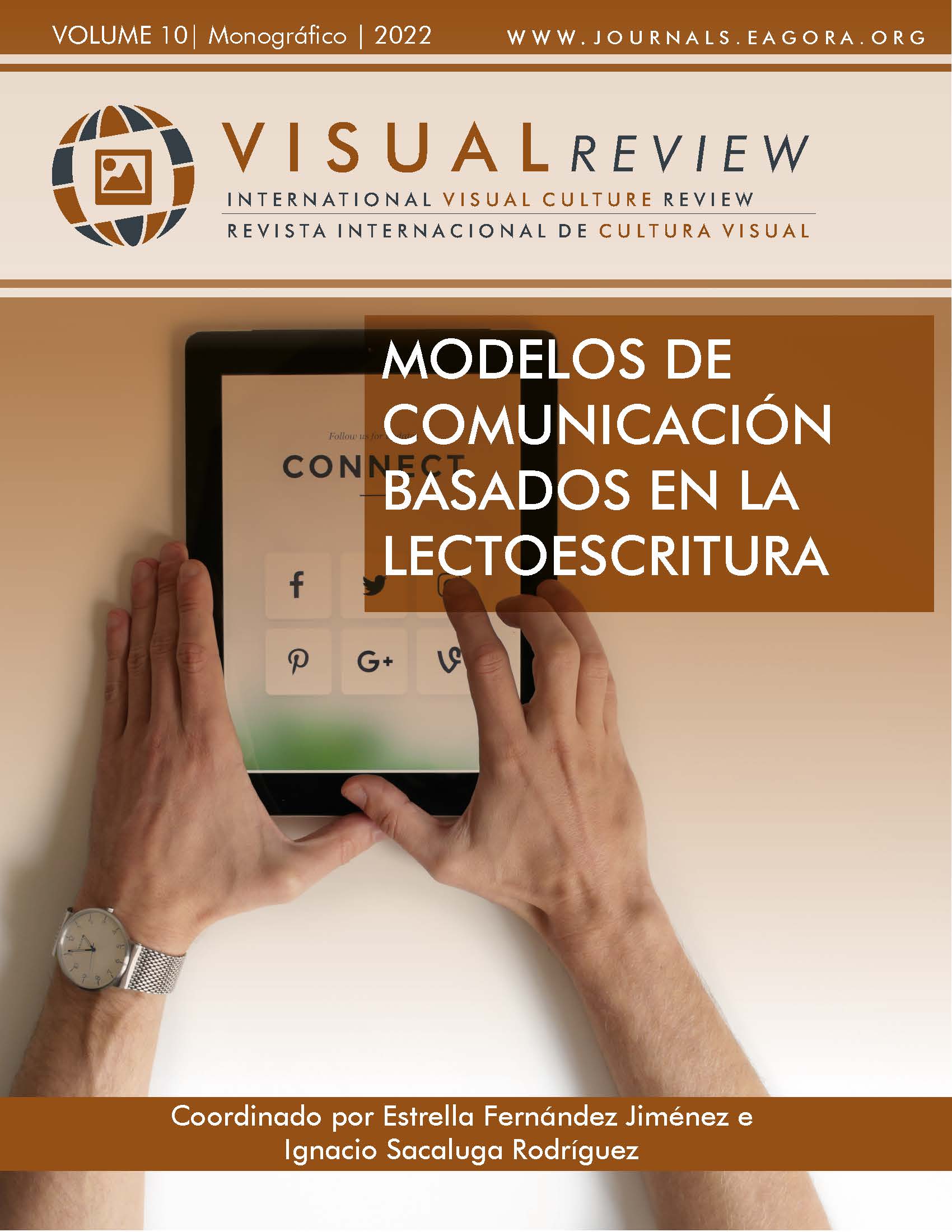Corporal deregulation through digital devices
DOI:
https://doi.org/10.37467/revvisual.v9.3602Keywords:
deregulation, body, students, devices, affection, touch, InstagramAbstract
This study sought to establish the corporal deregulation that is seen in the bodies of students using digital devices like Instagram. The methodology used was comprised of a visual analysis, literary review and thematic interviews. The conclusions revealed the joining of human and non-human bodies in an organized regime, a governmentality, in which techniques and stereotypes of gender and race circulate, from which bodies are molded and reproduced through the digital device; a government without governing bodies in the context of the social distancing of the Covid-19 pandemic and the crisis of bodily touch.
Downloads
Global Statistics ℹ️
|
557
Views
|
240
Downloads
|
|
797
Total
|
|
References
Agamben, G. (2011). ¿Qué es un dispositivo? Sociológica, 26 (73), 249-264.
http://www.scielo.org.mx/pdf/soc/v26n73/v26n73a10.pdf
Alonso, G. y Morgade, G.(2008). Cuerpos y sexualidades en la escuela. Paidós.
Alvarado, C. (2018). Instagram: autoconcepto y autoestimaen la adolescencia. Desarrollo de la identidad personal en las nuevasrealidadessociales. Publicaciones didácticas, 92, 305-311.https://core.ac.uk/download/pdf/235853992.pdf
Antelo, M (2017). Expresión de la subcultura de la belleza física alternativa en Instagram: El papel de los influencers. Revista aportes de la comunicación, 23, 9-22.
http://www.scielo.org.bo/pdf/racc/n23/n23_a02.pdf
Bardet, M. (2016). Pensar con mover. Un encuentro entre danza y filosofía. Editorial Cactus.
(2019). Hacer mundo con gestos. Editorial Cactus.
Bulo, V. (2019). Desde el cuerpo a la materialidad. Contribuciones de Jean-Luc Nancy. Revista de Filosofía, 76, 29-37.
http://dx.doi.org/10.4067/S0718-43602019000200029 DOI: https://doi.org/10.4067/S0718-43602019000200029
Butler, J. (2002). Cuerpos que importan. Paidós.
(2007). El géneroendisputa. El feminismo y la subversión de la identidad. Paidós.
Bogdan, R. y Taylor, S. (1987). Introducción a los métodos cualitativos de investigación. La búsqueda de significados. Paidós.
De Landa, M. (2021). Teoría de los ensamblajes y complejidad social. Ediciones Tinta Limón.
Deleuze, G. y Guattari, F. (2005). Rizoma. Pre-textos.
Deleuze, G. (1987). Foucault. Paidós. DOI: https://doi.org/10.5040/9781350252004
Fonseca, C., Infante, M. y Salinero, S. (2014). Autorretrato y espacios de significación. Un acercamiento al uso de la fotografíaen la construcción de subjetividades. En J.P.Concha y C. Robles (Eds.). Estética y Técnica en América Latina. Pontificia Universidad Católica de Chile. Instituto de Estética.
Flusser, V. (2017). La imagen. En G. Indij y A. Silva (Comp.). Clic! Fotografía y percepción. La Marca Editora.
García, V.(2019). Estética del sujeto hipermediatizado. Edición, estilización y curaduría del yo en la red. ASRI Revista de investigación. (17), 12-24.
https://dialnet.unirioja.es/servlet/articulo?codigo=7150895
García, L., Sánchez, A., Díaz, A. y García, D. (2017). Instagram y jóvenes de octavo grado: construcción de signos en una red social. Tesis de grado en Educación Básica. Pontificia Universidad Javeriana.http://hdl.handle.net/10554/21111
Hernández, K., Yanez, J. y Carrera, A.(2017). Las redes sociales y adolescencias. Repercusión en la actividad física. Revista Universidad y Sociedad, 2 (9), 242-247. http://scielo.sld.cu/scielo.php?script=sci_arttext&pid=S2218-36202017000200033
Horst, H., Hjorth, L., Lewis, T., Pink, S., Postill, J. y Tacchi, J. (2019). Etnografía digital. Principios y práctica. Ediciones Morata.
Jaramillo, L. y Murcia, N. (2001). La complementariedadcomoposibilidaden la estructuración de diseños de investigacióncualitativa. Cinta de Moebio, 12, diciembre, 194-204.
https://www.redalyc.org/articulo.oa?id=10101204
Lemon, N. (2008). Looking through the eyes of a child through the lens of a camera. In J. Moss (Ed.). Researching Education.Visually- Digitally-Spatially. Sense Publishers.
Lipovetsky, G. y Serroy. J. (2015). La estetización del mundo. Editorial Anagrama.
Mera, T. y Rojas, C. (2018). Instagram: una nueva plataforma publicitaria. Memoria título de periodista. Universidad de Chile. https://repositorio.uchile.cl/handle/2250/150648
Meyer, M. (2007). Increasing the frame: interdisciplinarity, transdisciplinarity and representativity. Interdisciplinary science reviews, 3, 203-212. DOI: https://doi.org/10.1179/030801807X211702
https://www.tandfonline.com/doi/abs/10.1179/030801807X211702
Morgade, G. (2001). Aprender a ser mujer, aprender a ser varón. Novedades Educativas
Nancy, J. (2003). Corpus. Editorial Arena.
(2013). Archivida. Del sintiente y del sentido. Editorial Quadrata.
Rose, G. (2019). Metodologías visuales. Una introducción a la investigación con materiales visuales. CENDEAC.
Rose, N. (1999). Powers of Freedom. Reframing political thought. Cambridge University Press. DOI: https://doi.org/10.1017/CBO9780511488856
(2007). The politics of life itself: biomedicine, power, and subjective y in thetwenty- firstcentury. Princeton University Press.
Sibila, P. (2005). El hombre postorgánico. Cuerpo, subjetividad y tecnologías digitales. Fondo de cultura económica.
(2008). La intimidad como espectáculo. Fondo de Cultura Económica.
Otaño, S. (2016). Selfies: autorretratos de la contemporaneidad. VIII Congreso Internacional de Investigación y Práctica Profesional en Psicología. XXIII Jornadas de Investigación. XII Encuentro de Investigadores en Psicología del MERCOSUR. Facultad de Psicología -Universidad de Buenos Aires. https://www.aacademica.org/000-044/35.pdf
Viveros, M. (2016). La interseccionalidad: una aproximaciónsituada a la dominación. Debate Feminista, 52, 1-17.https://doi.org/10.1016/j.df.2016.09.005 DOI: https://doi.org/10.1016/j.df.2016.09.005
Downloads
Published
How to Cite
Issue
Section
License
Those authors who publish in this journal accept the following terms:
-
Authors retain copyright.
-
Authors transfer to the journal the right of first publication. The journal also owns the publishing rights.
-
All published contents are governed by an Attribution-NoDerivatives 4.0 International License.
Access the informative version and legal text of the license. By virtue of this, third parties are allowed to use what is published as long as they mention the authorship of the work and the first publication in this journal. If you transform the material, you may not distribute the modified work. -
Authors may make other independent and additional contractual arrangements for non-exclusive distribution of the version of the article published in this journal (e.g., inclusion in an institutional repository or publication in a book) as long as they clearly indicate that the work was first published in this journal.
- Authors are allowed and recommended to publish their work on the Internet (for example on institutional and personal websites), following the publication of, and referencing the journal, as this could lead to constructive exchanges and a more extensive and quick circulation of published works (see The Effect of Open Access).













